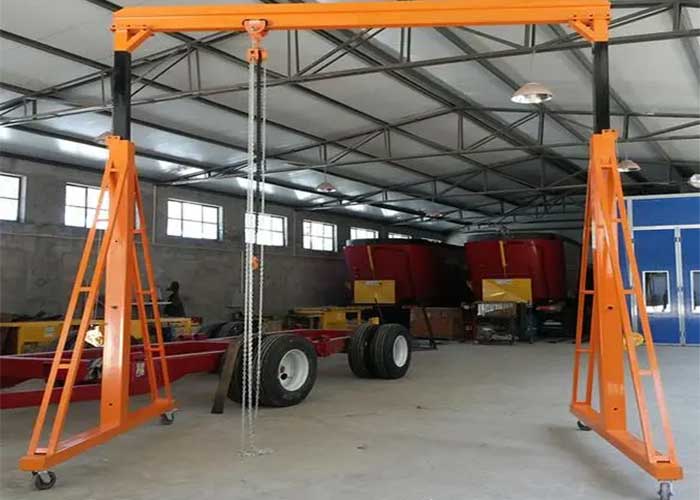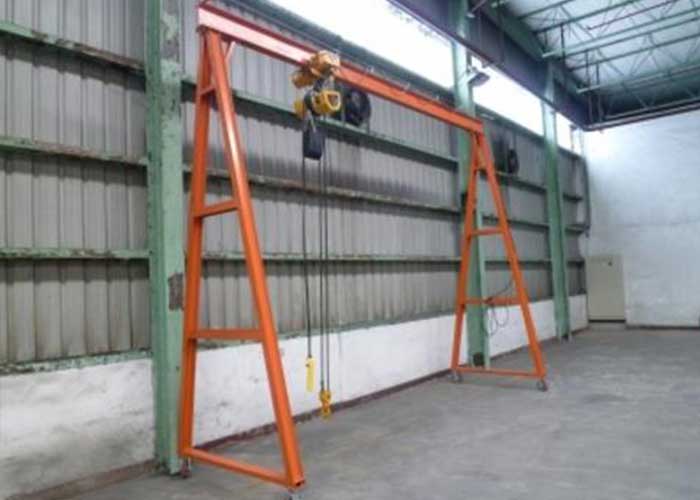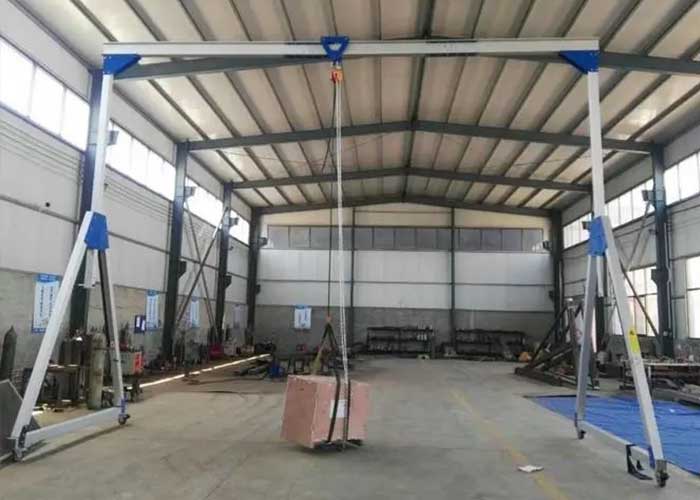Light Duty Gantry Crane, Good Price Light Gantry Crane
Light duty gantry crane for sale, light duty steel gantry & aluminium gantry crane, fixed height & adjustable light gantry crane for indoor & outdoor use.
Light duty gantry cranes, characterized by their sturdy yet maneuverable structure, are indispensable tools used for lifting and transporting loads within various work environments. Unlike their heavier counterparts, these cranes are designed with portability and flexibility in mind, offering an ideal solution for tasks that require frequent relocation or a lighter load capacity.
Their significance reverberates across diverse industries. From construction sites where materials need to be precisely maneuvered, to warehouses orchestrating the movement of inventory, and even in the agricultural sector aiding in the handling of produce – light duty gantry cranes prove their mettle in streamlining operations.
In the manufacturing and assembly realm, these cranes showcase their versatility by facilitating the assembly of machinery and assisting in the efficient movement of components across the production floor. Even in the marine sector, where space can be limited and loads need to be carefully managed, these cranes find their niche.
Light duty portable gantry cranes for sale
Light Duty Gantry Cranes for Sale
A foundational grasp of light duty gantry cranes is essential before delving into selecting the right fit. Let's explore the key components, variations, lifting mechanisms, as well as the advantages and limitations of these invaluable tools.
Light duty gantry cranes, at their core, consist of a horizontal beam supported by vertical legs that form a gantry shape. These cranes are often portable and can be moved to different locations as needed. The basic components typically include the beam, legs, trolley, hoist, wheels or casters, and in some cases, outriggers for added stability.
Types of Light Duty Gantry Cranes
- Adjustable Gantry Cranes:Designed with adjustable height or width to accommodate varying loads or spaces.
- Portable Gantry Cranes:Known for their mobility, they can be easily transported and set up at different locations.
- Aluminum Gantry Cranes:Lightweight yet durable, ideal for applications where weight is a concern.
- Others:Specialized variations cater to specific industries or unique requirements.
Light duty gantry cranes typically range in load capacity from a few hundred pounds to a few tons, depending on the specific model. Lifting mechanisms include manual hand chain hoists, electric chain hoists, or wire rope hoists, offering different weight capacities and control options.

Portable gantry crane for sale with fixed height design

Aluminum Lightweighted Gantry Cranes
Advantages and Limitations of Light Duty Gantry Cranes
Advantages:
- Portability:Easily movable to different locations within a workspace.
- Adaptability:Various types and configurations suit diverse operational needs.
- Ease of Setup:Quick assembly and disassembly for convenience.
- Cost-Effective:Compared to larger cranes, they often come at a lower price point.
Limitations:
- Lower Load Capacity:Not suitable for heavy lifting tasks.
- Height and Reach:Limited in terms of lifting height and reach compared to heavier cranes.
- Stability:May require additional stabilization for heavier loads or in windy conditions.
Industrial Sectors and Specific Applications
The versatility of light duty gantry cranes finds its essence in various industries, each harnessing these cranes to streamline operations and enhance efficiency. Let's explore the specific applications in different industrial sectors:
Construction Industry
In the realm of construction, where materials need precise handling and movement, light duty gantry cranes prove indispensable. These cranes aid in lifting and transporting building materials like steel beams, concrete blocks, and other construction supplies to different sections of the site. Their portability and maneuverability make them ideal for both indoor and outdoor construction tasks.
Warehousing and Logistics
Efficient warehouse operations depend on swift and accurate movement of goods. Light duty gantry cranes find their place in warehouses for tasks such as loading and unloading inventory, relocating heavy items within the warehouse, and organizing stock. Their adaptability allows for easy integration into existing warehouse setups, optimizing space and workflow.
Manufacturing and Assembly
Within manufacturing units, light duty gantry cranes aid in assembling components, positioning machinery parts, and handling materials on the production floor. These cranes facilitate the smooth flow of materials and contribute to increased productivity by simplifying the movement of goods during the manufacturing process.
Agriculture and Farming
In the agricultural sector, light duty gantry cranes assist in handling farm equipment, transporting produce, or supporting tasks like lifting and moving livestock feed. Their mobility allows farmers to adapt these cranes for diverse purposes, enhancing efficiency and reducing manual labor.
Marine and Shipyard Operations
Space constraints in marine and shipyard operations demand specialized equipment. Light duty gantry cranes are utilized for tasks like loading/unloading cargo, placing engines or parts within vessels, and moving heavy equipment around the limited space of shipyards.
Other Industries and Their Unique Requirements
- Automotive Industry:Used for engine assembly, parts handling, and vehicle maintenance.
- Renewable Energy Sector:Assists in the installation of solar panels and wind turbine components.
- Aviation Industry:Supports aircraft maintenance, engine handling, and parts assembly.
Factors to Consider Before Purchasing
Selecting the right light duty gantry crane entails a thoughtful assessment of various critical factors. Let's delve into the key considerations that buyers should weigh before making their purchase:
Load Capacity and Lifting Height Requirements
Understanding the weight of loads that need to be lifted and the required lifting height are fundamental aspects. Different light duty gantry cranes offer varying load capacities and lifting heights. Ensure the crane's specifications align with your operational needs to avoid overloading or height limitations during tasks.
Mobility and Portability Needs
Evaluate the necessity for mobility within your workspace. Portable gantry cranes with wheels or casters offer greater flexibility for tasks that require movement across different areas. Adjustable or foldable cranes might be advantageous for spaces with limited storage or varying load sizes.
Material and Construction Quality
Durability and longevity rely on the quality of materials used in constructing the crane. Aluminum cranes, for instance, offer lightweight yet robust solutions, while steel provides sturdiness for heavier loads. Assess the quality of components such as the beam, legs, and hoisting mechanisms for reliability.
Power Source and Energy Efficiency
Consider the power source for the crane's lifting mechanism. Electric, manual, or pneumatic options exist, each with its advantages. Additionally, prioritize energy-efficient models that can contribute to cost savings in the long run.
Safety Features and Compliance with Regulations
Safety should be paramount. Look for cranes equipped with safety features like overload protection, emergency stop buttons, and limit switches. Ensure the crane adheres to industry standards and regulations, guaranteeing safe operation within your workspace.
Customization Options for Specific Industry Needs
Explore customization possibilities offered by manufacturers to tailor the crane to your specific industry requirements. This might include modifications in the lifting mechanism, beam length, or additional accessories to optimize functionality.
By meticulously assessing these factors, buyers can make informed decisions when choosing a light duty gantry crane that aligns seamlessly with their operational demands. In Part V, we'll explore how to navigate the selection process and find the right crane amidst the myriad of options available in the market.
Choosing the Right Light Duty Gantry Crane
Amidst the array of options available, selecting the perfect light duty gantry crane requires a systematic approach. Let's explore the essential steps to streamline the decision-making process:
Evaluating Vendors and Manufacturers
Researching and evaluating reputable vendors and manufacturers is crucial. Consider their industry experience, reputation, certifications, and customer reviews. Opt for companies known for their quality products and excellent customer service.
Understanding Product Specifications and Technical Details
Dive into the technical specifications of the cranes offered. Pay close attention to load capacity, lifting height, material quality, and any additional features or customization options. Ensure these align closely with your operational requirements.
Comparing Prices, Warranties, and After-Sales Services
Compare prices among different vendors while keeping in mind the value offered. Consider factors beyond the initial cost, such as warranty periods, maintenance services, and after-sales support. A reliable warranty and excellent after-sales service can add significant value to your purchase.
Reviews and Testimonials from Other Buyers
Seek out reviews and testimonials from other buyers or industry experts who have experience with the specific model or manufacturer you're considering. These insights can provide valuable real-world perspectives on the crane's performance, reliability, and overall satisfaction.
By diligently following these steps, buyers can navigate through the myriad of options available and make an informed decision when selecting the right light duty gantry crane. In Part VI, we will explore the process of customizing specifications for those seeking tailored solutions to meet specific industry needs.
Customized Specification and Design
For buyers seeking a tailored solution to match their unique industry demands, collaborating with manufacturers for customized light duty gantry cranes is a promising avenue. Let's explore the process and advantages of customization:
Collaborating with Manufacturers for Customized Solutions
Manufacturers often provide the opportunity for collaboration to create bespoke solutions. Engaging in discussions with manufacturers enables buyers to communicate their specific requirements, allowing for the creation of a crane that precisely suits their operational needs.
Design Considerations for Specific Applications
Tailoring the design of a gantry crane involves considering the intricacies of its intended application. Whether it's adapting the crane's dimensions, load capacity, or lifting mechanisms, customizations are made to optimize its performance within the intended environment.
Tailoring Features to Meet Unique Industry Demands
Different industries have distinct operational needs. Customizations might involve incorporating specialized accessories, safety features, or modifying the crane's structure to align with industry-specific standards. These tailored features enhance efficiency and safety in the workspace.
Examples of Successful Customized Solutions
Examples of successful customized solutions can serve as inspirations for prospective buyers. Case studies or success stories showcasing how tailored gantry cranes improved operations in specific industries provide valuable insights into the benefits of customization.
Customizing a light duty gantry crane involves a collaborative effort between buyers and manufacturers to create a solution that perfectly aligns with unique industry demands. In Part VII, we'll delve into the essential maintenance and safety guidelines necessary to ensure optimal performance and longevity of these cranes.
Maintenance and Safety Guidelines
Ensuring the longevity of a light duty gantry crane and guaranteeing a safe working environment requires adherence to maintenance protocols and stringent safety measures. Let's explore the essential guidelines:
Regular Maintenance Practices for Prolonged Durability
Regular maintenance is key to ensuring the continued reliability of a gantry crane. This includes lubricating moving parts, inspecting components for wear and tear, checking electrical systems, and promptly addressing any issues to prevent potential breakdowns.
Safety Protocols and Training for Operators
Operator safety is paramount. Training operators on proper usage, safety protocols, and best practices significantly reduces the risk of accidents. Emphasize the importance of wearing appropriate personal protective equipment (PPE) and conducting routine safety checks before operating the crane.
Compliance with Industry Standards and Regulations
Adhering to industry standards and regulations is non-negotiable. Ensure the crane meets all safety standards and undergoes regular inspections as mandated by relevant authorities. This commitment to compliance mitigates risks and ensures a safe working environment.
Troubleshooting Common Issues and Solutions
Equip operators with the knowledge to identify and troubleshoot common issues that may arise during crane operation. This includes issues related to the hoisting mechanism, electrical components, or structural concerns. Implement a protocol for reporting and addressing issues promptly to avoid prolonged downtime.
By strictly adhering to maintenance practices, prioritizing safety protocols, compliance with regulations, and empowering operators with troubleshooting skills, buyers can maximize the lifespan of their light duty gantry crane while safeguarding the well-being of personnel. In Part VIII, we'll conclude by summarizing key points and emphasizing the significance of informed decision-making when purchasing these cranes.
Conclusion: Get Your Custom Light Gantry Cranes
In the expansive realm of industrial operations, the selection of the right equipment, such as light duty gantry cranes, is pivotal. As we draw to a close, let's recap the key takeaways from this comprehensive guide:
- Understanding load capacity, lifting height, and mobility needs are fundamental factors.
- Quality, compliance with safety standards, and after-sales services are paramount considerations.
- Customization options and collaboration with manufacturers cater to unique industry demands.
- Maintenance practices and adherence to safety protocols ensure prolonged efficiency.
Making an informed decision when purchasing a light duty gantry crane necessitates thorough research. Evaluating vendors, understanding technical specifications, comparing prices, and leveraging reviews are critical steps. Informed decision-making ensures the crane aligns perfectly with operational needs.
Every industry and operational environment has its unique requirements. It's imperative for buyers to meticulously assess their specific needs before making a purchase. Considerations like load capacity, mobility, compliance, and customization options should be aligned with the operational context.
By considering these factors, undertaking comprehensive research, and ensuring alignment with specific operational requirements, buyers can confidently select a light duty gantry crane that optimizes efficiency while ensuring a safe and productive workspace.
We hope this guide has been an insightful resource, empowering buyers with the knowledge and guidance necessary to navigate the intricate landscape of light duty gantry cranes. Remember, a well-informed decision paves the way for enhanced operational efficiency and safety.




